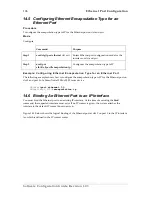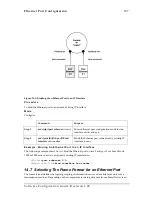
NAPT Configuration
101
Example: Adding a NAPT Entry
The following example shows how to add a static NAPT entry to profile
access
. All TCP packets,
arriving at the global interface at port
80
, are forwarded to the host with IP address
192.168.1.1
in the
local network. Use the following commands in configuration mode.
SN(cfg)#
profile napt access
SN(pf-napt)[access]#
static tcp 80 192.168.1.1
13.6 Removing a Static NAPT Entry
A static NAPT entry can be deleted, entering the inverted version of the command, e.g.
no static
protocol
port
.
Procedure
To remove a static NAPT entry
Mode
Configure
Command
Purpose
Step 1
node
(cfg)#show profile napt
name
Lists all persistent configurations for the NAPT
profile
name
Step 2
node
(cfg)#profile napt
name
Selects the existing NAPT profile
name
for
modification
Step 3
node
(pf-napt)[
name
]#no static
{tcp | udp}
port
Removes explicitly configurations for the NAPT
profile
name
for global interface at port
port
Example: Removing a Static NAPT Entry
The following example shows how to remove a static NAPT entry from profile
access
. The static
NAPT entry configured for TCP using port
80
shall be removed. Use the following commands in
configuration mode.
SN(cfg)#
show profile napt access
NAPT profile access:
--------------------
ICMP default server: (none)
Protocol Port Destination Host
--------------- ----- ----------------
tcp 80 192.168.1.1
SN(cfg)#profile napt access
SN(pf-napt)[access]#no static tcp 80
13.7 Configuring an ICMP Default Server
Configures a host in the local network at IP address
ip-address
that shall get all ICMP messages from
the global network.
Procedure
To define an ICMP default server in the NAPT profile
name
Software Configuration Guide, Revision 1.03
Mode
Configure






























